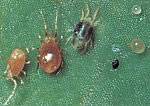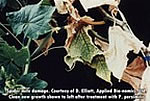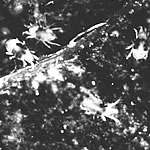Some Background

Spider mites, which are actually not insects, are members or the order Acari. The main distinguishing characteristic which differentiates this order from those of insects is the number of legs these creatures have. Insects have three pairs of legs; spider mites have four pairs. Mites are common pests of indoor plants the world over; there are, perhaps, thousands of mites belonging to several families which are known to phytophagous or plant-eating. There are many names for these pests, but most familiar are the words “spiders,” “mites” or, in the proper combined form, “spider mites.” We say proper because spiders are actually members of a different order, most commonly, Aranea.
Spider mites tend to be survivors, often — depending upon species — doing their best in hot, dry conditions unfavorable to many pests. In the United States the number-one spider mite pest is what is known as the two-spotted mite (whose adults have a dark spot on each side of their body and is sometimes connected over the back to present a saddle-bag-like appearance). They are also known as red mites due to their overwintering coloration. Scientifically they are known as Tetranychus urticae and will be the major topic of this chapter. However, there are a number of other species which can also wreak havoc: the carmine, European, southern and citrus red mites; many other species of citrus mites; Acarid family mites (which includes the in-ground bulb mites); Eriophyid family mites; false spider mites; and Tarosonemid family mites as well as many others. Of main concern on this page will be the ubiquitous two-spotted mite as this is the species which is reportedly the most common mite pest.
Troubles with spider mites can start anytime, but two times of year are especially problematic: In the winter when humidity levels tend to drop from the greenhouse heater pumping out warm air coupled with the usual lack of plant material and less rigorous irrigation schedule; and in the summertime when greenhouse temperatures are on the borderline oven-bake setting. In interiorscapes, the usual occurrences are in the winter, mostly due to the building’s heating system cranking out dry air all the time. In interiorscapes, due to lower light levels, the plants tend to be more stressed in the wintertime, too, and thus more vulnerable. But mites can infest plants anytime-these eight-legged demons are very opportunistic.
How They Become a Problem
Indoors, the infestation process typically begins as people come into contact with the plants. Spider mites are known hitchhikers, and if, let’s say interiorscaper technicians or greenhouse scouts, proceed in their duties from one account to the next, or from one greenhouse customer to the next, the mites can be carried with them and deposited in a new location. Outdoors, though mites are not flyers and have no wings, they can soar like birds on the slightest gusts of wind. Because mites are small, the two-spotted mite ranging from 0.3 to 0.5 millimeters in size, they are not typically noticed while roaming.
Two-spotted mites, many of which go through a red-coloration phase in the winter (depending on location), live through those bleak months in plant and weed debris, cracks in floors, and any out-of-the-way places they can lie undisturbed. For this reason, if your facility ever becomes infested with these pests, it is advisable to do an extremely thorough cleaning before planting new crops in anticipation of another growing season. If you don’t you’ll run a very high risk of having spider mites visit your crops again. And this is true of any of the mites listed herein.
A Serious Pest
Most spider mite pests can reproduce at alarming rates. Fortunately most are readily visible to an observant scout with keen eyes (though a hand lens helps a lot), a focus of what to look for, and a meticulous approach with a certain clarity in their duty. Some mites, however, are so small, like the Acarid family mites, Eriophyid family mites and Tarosonemid family mites, that they may go unchecked for a considerable period of time before their presence is noted. With many of these small mites it is their damage which is first detected. And often there is a huge period of time before the greenhouse or interiorscape managers can figure out and isolate the causation. Typically, unless those whose task it is to identify these problems has prior experience with these little mites, one must out-source the identification task to experts. Even many cooperative extension officers lack the experience necessary to identify these pests, so the period of waiting for the final identifier to come to your aid may take some time. However, since many scouts have difficulty seeing even the comparatively large two-spotted spider mites, even they are often discovered only by the damage they cause or the webbing they produce.
Some Advice

Two-spotted mites, and very few others, spin silk. At least in the beginning stages of an infestation, this silken webbing is strung from one half of a leaf’s underside, across the midrib, to the other half of the leaf. This forms a tent-like haven in which the females can lay their tiny pearl-like eggs and raise their young. The best way to view these meager beginnings of a colony-in-the-making is to eyeball along the midrib against a good light source. If the infestation isn’t noticed early on, the webbing will make itself apparent as it has been known to engulf whole leaves, flowers, even entire plants. This webbing is also a good place to wage war against these pests. As written in “The I in IPM” page, wiping leaves [read: wiping webs] with a soapy sponge is a practice which can help in the battle against two-spotted and other web-producing spider mites. Please note, however, if you see tiny, individual silken strands randomly strung from one plant to another any distance greater than one inch, you’re probably not seeing spider mite webbing. Instead, especially if seen in a structure where chemicals are not used, you’ll have spiders working in your facility. You, therefore, will have no reason for alarm. Spiders, though creepy, are good guys to have around as they eat insects. Do keep an eye on the situation, though. And remember, too many spider webs can impact your population of other good critters, like parasitic wasps, since spiders are not very selective in their predatory ways.
For The Scout
Spider mites, if not detected and controlled early in the game, before damaged parts can be auto-corrected and outgrown by the continued development of the plants, can cause considerable economical damage to an otherwise salable crop. A spider mite feeds by inserting its piercing mouthpart into the phloem or inner cells of a plant. The mite collapses the cells by drawing the plant’s juices or sap. This feeding activity will normally show up as clusters of individual cells which are yellowish and sunken. The plant will take on a stippled appearance. Mites are very capable of transmitting plant diseases, but are seldom responsible because they stay put unless hitchhiking or getting blown around. Diseases will be the least of your worries. Between the chlorotic stippling and the webbing, though, infested plants can look pretty unhealthy — especially as their dying leaves begin to dry up, shrivel and fall off.
Outdoors, two-spotted mites and many other species fare less well, what with having to cope with Mother’s wrath. Mother Nature, that is. Rain storms and high winds-and even natural enemies-have a considerable impact on many of these mites. If you could just move the plants outside for even a little while. There are many ways to put mites to the test. What with web-wiping, increasing the humidity by misting and spraying your plants with plain water, and the vast array of predatory insects and mites available to eat them, spider mites are a fairly simple pests to deal with. Unless, of course you get hit with one of those less common spider mite pests mentioned at the beginning of this page. Those, though little in stature, take a big bite and can be a much greater challenge.
Some Solutions
There are many biological pest control agents available to specifically address spider mite pests. Some, like the Neoseiulus fallacis predatory mite species can be used preventively-which is highly recommended, especially when considering the awesome destructive potential of these pests. Other predatory mites, such as Phytoseiulus persimilis are very good at really reducing a given population. Sulfur sprays can really help and are reasonably safe to use. They’re especially useful for targeting the less-common families of pest mites. Chemical controls can also be effective, but great care must be taken as spider mites can easily develop resistance to many pesticides.


